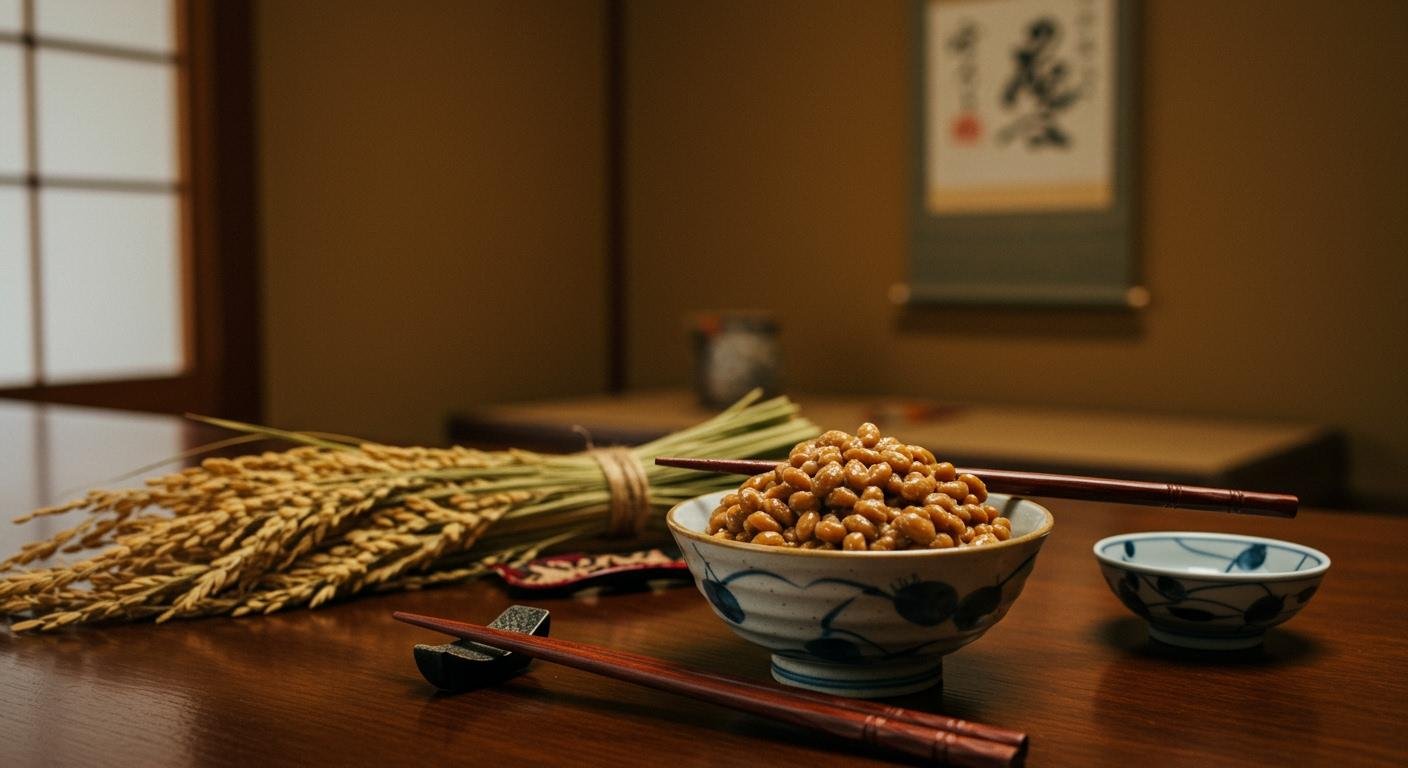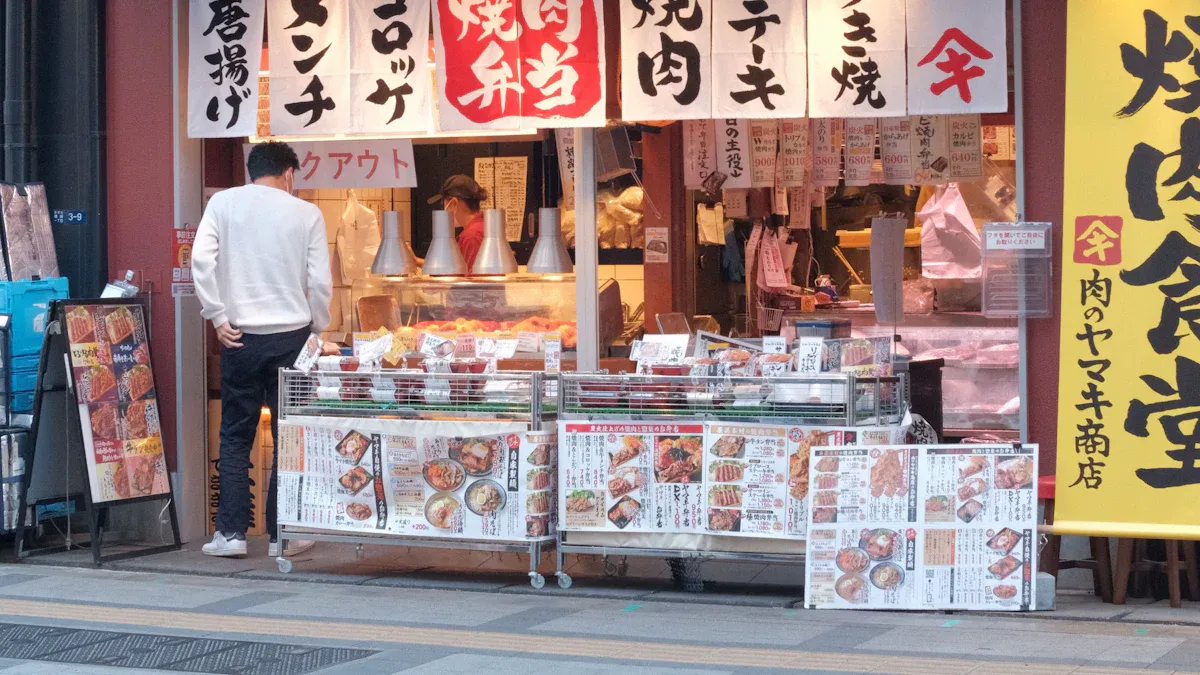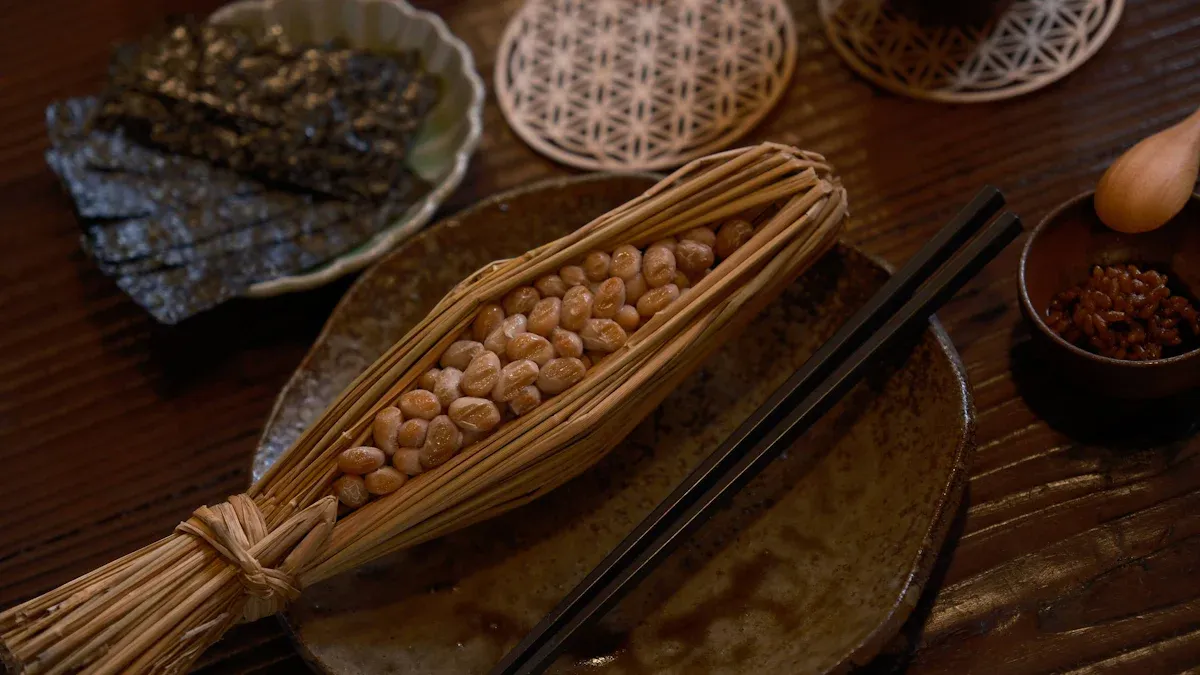Exploring the History of Natto in Japan
Table of Contents

The history of natto is full of mystery. Natto is a traditional food in Japan made from fermented soybeans. This fermentation process gives natto its famous sticky texture and strong, pungent aroma. The distinct smell of natto comes from several compounds.
This includes acids, nitrogenous compounds, sulphides, and phenols.
The true origin of natto in Japan remains a fascinating puzzle. This simple natto holds a deep and compelling story, making natto a truly unique food. The journey of this humble natto is remarkable.
THE ANCIENT HISTORY OF NATTO

The complete history of natto is complex. Several compelling theories attempt to explain its origins. These stories span from accidental discoveries in ancient Japan to influences from neighboring China. Each theory provides a unique glimpse into the possible beginnings of this iconic food.
ANCIENT ROOTS
One theory places the birth of natto deep in Japan’s own past. Researchers suggest natto could have originated during the Yayoi period (300 BC – 300 AD). People in ancient Japan had all the necessary components for making natto. They cultivated soybeans. They used rice straw for various purposes. The humid climate of Japan provided the warmth needed for bacteria to thrive.
An Accidental Creation? 🛖 The theory proposes an accidental discovery. Cooked soybeans might have been stored in or near rice straw. The naturally present bacteria on the straw, Bacillus subtilis, would have started the fermentation process. This simple interaction could have created the very first natto.
Archaeological findings support this idea. Excavations in Akita have uncovered charred soybeans alongside Yayoi earthenware. This suggests that people consumed soybeans long ago. This evidence makes an early, independent origin for natto within Japan a strong possibility. The creation of natto may have been a happy accident.
CHINESE INFLUENCE
Another prominent theory points to a Chinese origin. It suggests that a precursor to natto arrived in Japan during the Nara period (710-794 AD). This product was a type of salt-free fermented soy nugget known as kuki or tan-shih. Buddhist monks and immigrants played a key role in bringing these food technologies to Japan.
A famous Chinese Buddhist priest named Ganjin arrived in Japan in 754 AD. He reportedly brought large quantities of these soy nuggets with him. His temple later prepared and sold this early form of natto. The introduction of these products likely inspired the development of natto in Japan. Historical records from this era document the presence of these soy nuggets.
| Type of Record | Date | Details |
|---|---|---|
| Wooden Tax Placards | 746 AD | Placards found at Heijokyo palace show soy nuggets were used as tax payments. |
| Written Documents | 770 AD | Texts like the Issetsu Kyosho Kaibun mentioned kuki (soy nuggets). |
| Monk Accounts | 754 AD | The priest Ganjin arrived from China with salt-free soy nuggets. |
| Agricultural Encyclopedia | Late 700s | The Chinese text Ch’i-min yao-shu, describing soy nuggets, arrived in Japan. |
These records show that fermented soy products were known and valued in Japan over a thousand years ago. This influence from China is a critical part of the history of natto. The Japanese likely adapted these methods to create their own unique natto.
SAMURAI FOLKLORE
Perhaps the most famous story about natto involves a legendary samurai. This popular tale credits the discovery of natto to Minamoto no Yoshīe, a general from the Heian Period. The legend takes place during the Gosannen War in the 1080s.
Yoshīe’s army was campaigning in northeastern Japan. One evening, his soldiers were boiling soybeans for their horses. Suddenly, they were attacked. The soldiers hastily packed the warm, cooked soybeans into sacks made of rice straw. They tied these sacks to their horses and fled.
The heat from the horses’ bodies created a perfect incubator. For the next day or two, the soybeans fermented inside the straw sacks. When the soldiers finally opened the bundles, they found the beans had transformed. The soybeans were sticky and stringy. Despite the strange appearance, they tasted the natto and found it delicious and energizing. This accidental discovery by warriors helped popularize natto. The first documented use of the word “natto” also appeared around this time, in 1068. By the Kamakura period (1185-1333), natto was an important protein source in the vegetarian cuisine (shojin ryori) of Buddhist monks and samurai, cementing its place in Japanese food culture. This story firmly links natto to the strength and resilience of the samurai.
THE RISE OF NATTO IN JAPAN
Following its mysterious origins, natto began a slow but steady journey into the heart of Japanese cuisine. The food did not become popular overnight. Instead, its acceptance grew region by region, solidifying its place as a staple food. This chapter in the history of natto shows how it transformed from an accidental discovery into a cultural mainstay.
SPREAD ACROSS JAPAN
The Kanto and Tohoku regions of eastern and northeastern Japan became the primary centers for natto consumption. These areas had limited access to fresh fish due to mountainous terrain and distance from major ports. This geographical challenge forced people to find other protein sources. Soybeans became a crucial part of their diet.
The Tuna of the Mountains ⛰️ People in these regions valued soybeans so highly that they called them ‘tuna of the mountains.’ This nickname highlights the importance of soybeans and natto as a protein source where fish was scarce. The long, cold winters also required foods that could be preserved, making natto an ideal choice.
The legend of Minamoto no Yoshīe also played a part in spreading natto. After his military campaigns, the general supposedly taught natto-making techniques along a route known as the “Natto Road.” This path passed through key locations in Kanto and Tohoku, including Mito, which would later become famous for its natto.
Buddhist monks also helped popularize natto. Natto became an essential ingredient in their vegetarian cuisine, known as shojin ryori. This diet strictly forbids meat, so monks relied on processed soy foods for protein. Natto was served alongside other staples like tofu, yuba (tofu skin), and abura-age (fried tofu puffs), often paired with seasonal mountain vegetables. The adoption of natto by monks gave the food a respected status.
The government also unintentionally helped spread natto. In 1635, the sankin kotai system required feudal lords to live in the capital city of Edo (modern-day Tokyo) for part of the year. This policy forced lords and their retainers to travel from regions like Tohoku and Kanto. They brought local foods, including natto, with them, introducing the dish to the capital’s massive population. This movement of people and culture helped natto gain a foothold in Japan’s largest city.
| Factor | Contribution to Natto’s Spread |
|---|---|
| Geography | Limited fish access made natto a key protein in Kanto & Tohoku. |
| Folklore | The “Natto Road” legend linked natto to heroic figures. |
| Religion | Buddhist monks used natto as a protein in shojin ryori. |
| Politics | The sankin kotai system brought natto from the provinces to Edo. |
Eventually, the city of Mito in the Kanto region became the undisputed capital of natto in Japan. The area grew an abundance of small-sized soybeans, which are perfect for the fermentation process. The opening of a new railway line in 1889 was a major turning point. Clever natto makers began selling their product as a souvenir at Mito Station. This strategy successfully cemented Mito’s reputation as the home of the best natto.
EDO PERIOD STREET FOOD 🏙️
As natto became more common, it transitioned from a regional specialty to a popular urban food. During the Edo period (1603-1868), Edo grew into one of the world’s largest cities. A vibrant street food culture emerged to feed its millions of residents. Natto vendors soon became a common sight on the city’s bustling streets.
These vendors did not sell the whole-bean natto we know today. Instead, they sold a product called tataki natto, which means “chopped natto.” The vendors would chop the sticky natto beans, making them easier to use. This prepared natto was a convenience food for busy city dwellers.
The main purpose of this street-side natto was for a quick and easy breakfast. Customers would buy the chopped natto to make a simple soup. This natto soup provided a warm, nutritious start to the day. The availability of natto also changed over time.
- In the early Edo period, vendors sold natto only during the winter.
- By the end of the period, natto was so popular that it was sold year-round.
This shift shows how deeply natto integrated into the daily lives of ordinary people in Japan. It was no longer just food for monks or samurai; it was an affordable and accessible meal for everyone. The rise of natto as a street food marked its final step toward becoming a national dish.
THE MODERNIZATION OF NATTO

The journey of natto from a traditional food to a modern staple is a story of scientific innovation. The 20th century brought revolutionary changes to how natto was made. These advancements made natto safer, more consistent, and available to everyone. The era of relying on unpredictable rice straw was coming to an end.
FROM STRAW TO SCIENCE
The biggest change in natto production happened during the Taisho Period (1912–1926). Scientists successfully isolated the key bacterium, Bacillus subtilis natto, in a laboratory. This breakthrough eliminated the need for rice straw in the fermentation process. Producers could now use a pure, reliable starter culture to make natto. This scientific approach transformed the entire industry.
Modern natto production is a highly controlled process. It begins with soaking and cooking high-quality soybeans. Workers then add the pure natto culture to the cooled beans. The mixture is packed into containers and moved to a temperature-controlled room for fermentation. This method produces a consistent and safe natto every time. The differences between the old and new ways are significant.
| Feature | Traditional Method (Rice Straw) | Modern Method (Pure Culture) |
|---|---|---|
| Bacteria Source | Naturally present on rice straw | Lab-grown pure natto culture |
| Contamination Risk | High risk from other microbes | Significantly reduced risk |
| Quality Control | Very difficult to maintain consistency | High control over natto quality |
| Process | Beans wrapped in straw, kept warm | Beans inoculated, packed, fermented |
Advanced packaging technology also improved the quality of natto. Modern systems use barrier films and airtight seals. These innovations extend the shelf-life of natto and protect it from contamination. This scientific approach ensures that the natto you buy is fresh, safe, and delicious.
A MODERN SUPERFOOD
Scientific discovery did not just change how natto is made; it also revealed why natto is so healthy. Today, natto is celebrated around the world as a superfood. This reputation is built on its incredible nutritional content, which has been confirmed by numerous studies. Natto is a powerhouse of essential nutrients.
The two most famous components of natto are Vitamin K2 and an enzyme called nattokinase. Research shows that Vitamin K2 is vital for bone health. It helps the body use calcium effectively, which may reduce the risk of fractures. Natto is one of the richest sources of this vitamin.
A 2000 study found that natto contains over 100 times more Vitamin K2 than unfermented soybeans. This makes natto a unique and powerful food for bone support.
Scientists are also studying nattokinase for its effects on cardiovascular health. Studies suggest this enzyme may help dissolve blood clots and support healthy blood pressure. The health benefits of natto have made it popular outside of Japan. Companies now market natto to health-conscious consumers globally. They use social media and partnerships with wellness brands to educate people about the advantages of eating natto. This modern marketing helps introduce a new generation to the amazing benefits of natto.
The history of natto shows a remarkable journey. This simple natto began as an ancient food in Japan. Today, science guides the fermentation of natto. Natto remains a symbol of traditional cuisine in Japan. The story of natto reflects the nation’s ability to adapt.
This humble natto represents both the past and future of food in Japan. The journey of natto in Japan is truly unique. Natto is a food with a deep story. This natto is special.
FAQ
What does natto taste like?
The taste of natto is complex and savory. It has a strong umami flavor, often compared to aged cheese or Marmite. The unique texture of natto is a major part of the experience. The powerful smell of natto also greatly influences its perceived taste.
How do you eat natto?
People traditionally eat natto for breakfast over a bowl of rice. They first stir the natto vigorously to develop its signature stickiness. Common additions include soy sauce and Japanese mustard. This simple preparation makes the natto ready to eat and enhances its flavor.
Why does natto have such a strong smell?
The fermentation process creates the strong smell of natto. The bacterium Bacillus subtilis breaks down proteins and sugars in the soybeans. This action releases pungent compounds, giving natto its distinct, ammonia-like aroma that some people find challenging.
Where can I buy natto?
You can find natto in the refrigerated or frozen sections of most Asian grocery stores. Some larger supermarkets with international food aisles also carry natto. It is typically sold in small, single-serving styrofoam or paper containers, often in packs of three or four.

Poseidon
Master of Nutritional Epidemiology, University of Copenhagen, Herbal Functional Nutrition Researcher
Focus: The scientific application of natural active ingredients such as Tongo Ali, Horny Goat Weed, and Maca to sexual health and metabolic regulation.
Core Focus:
Men: Use a combination of Tongo Ali (an energizing factor) + Maca (an energy reserve) to improve low energy and fluctuating libido.
Women: Use a combination of Horny Goat Weed (a gentle regulator) + Maca (a nutritional synergist) to alleviate low libido and hormonal imbalances.
Stressed/Middle-Aged Adults: This triple-ingredient synergy supports metabolism, physical strength, and intimacy.
Product Concept:
Based on traditional applications and modern research (e.g., Tongo Ali promotes testosterone-enhancing enzyme activity, and icariin provides gentle regulation), we preserve core active ingredients and eschew conceptual packaging—using natural ingredients to address specific needs.
Simply put: I'm a nutritionist who understands "herbal actives." I use scientifically proven ingredients like Tongo Ali, Epimedium, and Maca to help you make "sexual health" and "nutritional support" a daily routine.
